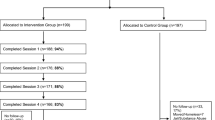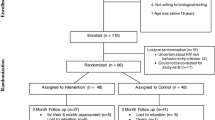Abstract
We conducted a randomized controlled pilot intervention to evaluate the efficacy of a telephone-based brief counseling intervention to reduce sexual risk taking among men who have sex with men (MSM) in Seattle, Washington. The study targeted individuals who were currently engaging in unsafe sex but were not committed to making changes toward safer behaviors. Counselors used motivational interviewing strategies in a single 90-min session to enhance readiness for change, promote greater intentions to use condoms, and to support safer sex practices. Results are based on 89 MSM randomly assigned to Immediate counseling or a Delayed counseling control condition. Among minority participants, Immediates were significantly less likely to have engaged in unprotected anal intercourse at follow-up, compared to Delays. Immediate participants reported significantly less ambivalence about practicing safer sex at follow-up, and tended to report greater increases in intentions to use condoms. These findings support the potential efficacy of a brief intervention based upon motivational enhancement principles for promoting safer sex practices among at-risk MSM.
Similar content being viewed by others
REFERENCES
Belcher, L., Kalichman, S., Toping, M., Smith, S., Emshoff, J., Norris, F., and Nurss, J. (1998). A randomized trial of a brief HIV risk reduction counseling intervention for women. Journal of Consulting and Clinical Psychology, 66, 531–541.
Bosga, M. B., de Wit, J. B. F., de Vroome, E. M. M., Houweling, H., Schop, W., and Sandfort, T. G. M. (1995). Differences in perception of risk for HIV infection with steady and nonsteady partners among homosexual men. AIDS Education and Prevention, 7, 103–115.
Centers for Disease Control and Prevention. (1994). HIV counseling, testing, and referral: Standards and guidelines. Atlanta, GA: Centers for Disease Control and Prevention.
Centers for Disease Control and Prevention. (1999a). HIV/AIDS Surveillance Report, 11(1), 33.
Centers for Disease Control and Prevention. (1999b). Resurgent bacterial sexually transmitted disease among men who have sex with men-King County, Washington, 1997–1999. Morbidity and Mortality Weekly Report, 48, 773–777.
Centers for Disease Control and Prevention. (2000). HIV/AIDS among racial/ethnic minority men who have sex with men-United States, 1989–1998. Morbidity and Mortality Weekly Report, 49, 4–11.
Cohen, J. (1992). A power primer. Psychological Bulletin, 112, 155–159.
Colby, S. M., Monti, P. M., Barnett, N.P., Rohsenow, D. J., Weissman, K., Spirito, A., Woolard, R. H., and Lewander, W. J. (1998). Brief motivational interviewing in a hospital setting for adolescent smoking: A preliminary study. Journal of Consulting and Clinical Psychology, 66, 574–578.
Dillion, B., Hecht, F., Swanson, M., Goupil-Sormany, I., Grant, R., Chesney, M., and Kahn, J. (2000, January). Primary HIV infection associated with oral transmission. Poster presented at the Seventh Conference on Retroviruses and Opportunistic Infections, San Francisco, CA.
Gentilello, L. M., Donovan, D. M., Dunn, C. W., and Rivara, F. P. (1995). Alcohol interventions in trauma centers; Current practice and future directions. Journal of the American Medical Association, 274, 1043–1048.
Glynn, R. J., and Buring, J. E. (1996). Ways of measuring rates of recurrent events. British Medical Journal, 312, 364–367.
Gribble, J. N., Miller, H. G., Cooley, P. C., Catania, J. A., Pollack, L., and Turner, C. F. (2000). The impact of T-ACASI interviewing on reported drug use among men who have sex with men. Substance Use and Misuse, 35, 869–890.
Hoff, C. C., Coates, T. J., Barrett, D. C., Collette, L., and Ekstrand, M. (1996). Differences between gay men in primary relationships and single men: Implications for prevention. AIDS Education and Prevention, 8, 546–559.
Kamb, M., Fishbein, M., Douglas, J., Rhodes, F., Rogers, J., Bolan, G., Zenilman, J., Hoxworth, T., Malotte, C. K., Iatesta, M., Kent, C., Lentz, A., Graziano, S., Byers, R. H., and Peterman, T. A. (1998a). Efficacy of risk-reduction counseling to prevent Human Immunodeficiency Virus and Sexually Transmitted Diseases. Journal of the American Medical Association, 280, 1161–1167.
Kamb, M. L., Rhodes, F., Hoxworth, T., Rogers, J., Lentz, A., Kent, C., MacGowen, R., and Peterman, T. A. (1998b). What about money? Effect of small monetary incentives on enrolment, retention, and motivation to change behavior in an HIV/STD prevention counseling intervention. Sexual Transmission Infection, 74, 253–255.
Kasprzyk, D., Monta”no, D. E., and Fishbein, M. (1998). Application of an integrated behavioral model to predict condom use: A prospective study among high HIV risk groups. Journal of Applied Social Psychology, 28, 1557–1583.
Kissinger, P., Kopicko, J. J., Myers, L., Wustrack, S., Elkins, W., Farley, T. A., and Martin, D. (2000).The effect of modest incentives on follow-up rates in sexually transmitted disease studies. International Journal of STD and AIDS, 11, 27–30.
Leigh, B. C., and Stall, R. (1993). Substance use and risky sexual behavior for exposure to HIV. American Psychologist, 48, 1035–1045.
Lemke, A. (1997). HIV/AIDS Program Development and Evaluation Unit, School of Social Work, University of Washington. Unpublished raw data.
McMahon, R. P., Proschan, M., Geller, N. L., Stone, P. H., and Sopko, J. (1994). Sample size calculation for clinical trials in which entry criteria and outcomes are counts of events. Statistics in Medicine, 13, 859–870.
Miller, W. R., Benefield, G. S., and Tonigan, G. S. (1993). Enhancing motivation for change in problem drinking: A controlled comparison of two therapist styles. Journal of Consulting and Clinical Psychology, 61, 455–461.
Miller, W. R., and Rollnick, S. (1991). Motivational interviewing: Preparing people to change addictive behavior. New York: Guilford.
Miller, W. R., and Sovereign, R. G. (1989). The check-up: A model for early intervention in addictive behaviors. In T. Loberg, W. R. Miller, P. E. Nathan, and G. A. Marlatt (Eds.), Addictive behaviors: Prevention and early intervention (pp. 219–231). Amsterdam: Swets and Zeitlinger.
Miller, W. R., Sovereign, R. G., and Krege, B. (1988). Motivational interviewing with problem drinkers: II. The Drinker's Checkup as a preventive intervention. Behavioural Psychotherapy, 16, 251–268.
National Institute of Mental Health (NIMH) Multisite HIV Prevention Trial Group. (1998). The NIMH multisite HIV prevention trial: Reducing HIV sexual risk behavior. Science, 280, 1889–1894.
Oakley, A., Fullerton, D., and Holland, J. (1995). Behavioral interventions for HIV/AIDS prevention. AIDS, 9, 479–486.
Prochaska, J. O., Redding, C. A., Harlow, L. L., Rossi, J. S., and Velicer, W. F. (1994). The transtheoretical model of change and HIV prevention: A review. Health Education Quarterly, 21, 471–486.
Roffman, R. A., Picciano, J. F., Bolan, M., and Kalichman, S. C. (1997a). Factors associated with attrition from an HIV-prevention program for gay and bisexual males. AIDS and Behavior, 1, 125–135.
Roffman, R. A., Picciano, J. F., Ryan, R., Beadnell, B., Fisher, D., Downey, L., and Kalichman, S. C. (1997b). HIV prevention group counseling delivered by telephone: An efficacy trial with gay and bisexual men. AIDS and Behavior, 1, 137–154.
Roffman, R. A., Picciano, J., Wickizer, L., Bolan, M., and Ryan, R. (1998). Anonymous enrollment in AIDS prevention group counseling: Facilitating the participation of gay and bisexual men in intervention and research. Journal of Social Service Research, 23, 5–22.
Rutledge, S. E., Picciano, J. F., King, K. A., and Roffman, R. A. (1999,August). Attrition from a brief motivational intervention to reduce unsafe sex behavior among MSM. Poster presented at the 1999 National HIV Prevention Conference, Atlanta, GA.
Ryan, R., Longres, J. F., and Roffman, R. A. (1996). Sexual identity, social support, and social networks among African-, Latino-, and European-American men in an HIV prevention program. Journal of Gay and Lesbian Social Services, 5, 1–24.
Sikkema, K. J., and Bissett, R. T. (1997). Concepts, goals, and techniques of counseling: Review and implications for HIV counseling and testing. AIDS Education and Prevention, 9(Suppl. B), 14–26.
Stout, R. L., Wirtz, P. W., Carbonari, J. P., and Del Boca, F. K. (1994). Ensuring balanced distribution of prognostic factors in treatment outcome research. Journal of Alcohol, 12(Suppl.), 70–75.
Thompson, M. M., Zanna, M. P., and Griffin, D. W. (1995). Let's not be indifferent about (attitudinal) ambivalence. In R. E. Petty and J. A. Krosnick (Eds.), Attitude, strength: Antecedents and consequences (pp. 361–386). New Jersey: Lawrence Erlbaum.
Washington State/Seattle King County. (1999). HIV/AIDS Quarterly Epidemiology Report, 2nd Quarter.
Weinhardt, L. S., Carey, K. B., and Carey, M. P. (2000). HIV risk sensitization following a detailed sexual behavior interview: A preliminary investigation. Journal of Behavioral Medicine, 23, 393–398.
Weinhardt, L. S., Forsyth, A. D., Carey, M. P., Jaworski, B. C., and Durant, L. E. (1998). Reliability and validity of self-report measures of HIV-related sexual behavior: Progress since 1990 and recommendations for research and practice. Archives of Sexual Behavior, 27, 155–180.
WHO Brief Intervention Study Group. (1996). A cross-national trial of brief interventions with heavy drinkers. American Journal of Public Health, 86, 948–955.
Author information
Authors and Affiliations
Rights and permissions
About this article
Cite this article
Picciano, J.F., Roffman, R.A., Kalichman, S.C. et al. A Telephone Based Brief Intervention Using Motivational Enhancement to Facilitate HIV Risk Reduction Among MSM: A Pilot Study. AIDS Behav 5, 251–262 (2001). https://doi.org/10.1023/A:1011392610578
Issue Date:
DOI: https://doi.org/10.1023/A:1011392610578




